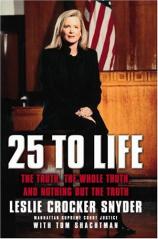25 to Life: The Truth, the Whole Truth, and Nothing But the Truth
Review
25 to Life: The Truth, the Whole Truth, and Nothing But the Truth
By almost anyone's standards, Leslie Crocker Snyder has a lousy
job.
Snyder is a Manhattan Supreme Court Justice, handling criminal
cases. (The "Supreme Court" in New York is not the highest appeals
court, as it is in some states; there's a not-particularly-helpful
diagram of the structure of the New York state court system in the
book for those who are interested.) She routinely draws the
toughest cases around; multi-defendant trials of drug gangs,
complex cases involving Mafia dons, and courtrooms with
spine-chilling murderers. She earns less than a first-year attorney
at a white-shoe Wall Street law firm. She has to deal with death
threats on a routine basis. She has to battle the dark forces of
sexism, and persuade state legislators towards reforming the penal
code. Worse, she has to work every day with "attorneys," and you
know what "they're" like.
The underlying question in 25 TO LIFE, Judge Snyder's story about
her legal career, is why she, or anyone else, would voluntarily
choose such a profession, voluntarily put themselves on the front
lines in New York City's continual struggle against crime. Snyder
makes it sound simple; she was bored. She was working in the
consumer fraud unit of the Manhattan district attorney's office,
and she hated it, and wanted to do something else, and ended up
working rape and homicide cases. Along the way, she helped change
the legal requirements for proving a rape case, and earned an
appointment to the bench. There, she developed a reputation for
harsh (although sometimes innovative) sentencing and became a
figure of dread among the defense bar.
It's clearly a rotten job, but one that Snyder enjoys. Despite its
grisly detailing of drug deals and homicides and Mafia extortion,
25 TO LIFE is something of a love letter. Judge Snyder writes
enthusiastically, almost passionately, about her profession and the
men and women in the criminal justice system she works with. If 25
TO LIFE does nothing else, it shows how rewarding, how vital, how
necessary a career in public service can be. It should be required
reading for law students.
Casual readers, though, won't find much to interest them in 25 To
LIFE. Unlike many lawyers, Snyder has a direct, conversational
style, but even her style can't get the reader through the
occasional impenetrable maze of legal technicalities. Her manifold
encounters with criminal defendants seem to run into each other
after awhile. And the book is marred here and there by unseemly
bits of self-congratulation, as Snyder pats herself on the back in
recounting her exploits. (She is particularly proud that a picture
of a stern judge in her likeness appears on heroin bags with the
caption, 25 TO LIFE hence the book's title.)
However, Judge Snyder isn't a writer by trade (the book was written
with author Tom Shachtman), but a jurist, for which New Yorkers can
be grateful and appreciative. 25 TO LIFE appropriately shows the
dangers and the glories of a life on the bench in the riskiest of
situations. It should remind all of us that our safety is largely
due to the hard, unacknowledged work of the police and attorneys
and judges who work in the criminal justice system, and that we owe
them a debt of honor that we cannot easily repay.
Reviewed by Curtis Edmonds (curtis@txreviews.com) writes movie reviews at http://www.txreviws.com/ on January 20, 2011
25 to Life: The Truth, the Whole Truth, and Nothing But the Truth
- Publication Date: September 23, 2002
- Genres: Autobiography, Nonfiction
- Hardcover: 352 pages
- Publisher: Warner Books
- ISBN-10: 0446530204
- ISBN-13: 9780446530200



